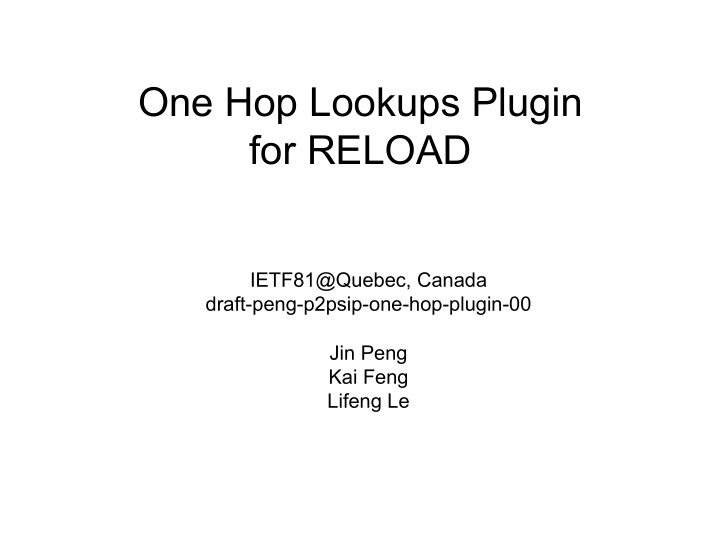



One Hop Lookups Plugin for RELOAD IETF81@Quebec, Canada draft-peng-p2psip-one-hop-plugin-00 Jin Peng Kai Feng Lifeng Le
Agenda • Why One Hop Lookups Plugin? • Peer data structure • Event notification procedure • Updates message • Leader choosing strategies • Fault tolerance
Why One Hop Lookups Plugin? • Topology Plugin of RELOAD • Each overlay can select an appropriate overlay algorithm that relies on the common RELOAD core protocols and code • High demands for the improvement of routing efficiency in real time applications • Chord: ! ¡( log # ) • One Hop Lookups: ! ¡(1)
Why One Hop Lookups Plugin? • Requirements for RELOAD • The one hop lookups plugin is based on the methods provided by RELOAD which include the framework of commonly-needed methods defined in the Topology Plugin. • RELOAD defines three methods for overlay maintenance: Join, Update and Leave. The one hop lookups plugin defines the contents of those message. • Based on the architecture of RELOAD to support different usages.
Peer data structure • Routing table • A full routing table contains information about every node in the overlay • Predecessor and successor information • Neighborhood information • Unit leader information • Slice leader information • Slice leader list
Event notification procedure X 1 2 2 Slice ¡leader Unit ¡leader 4 2 Ordinary ¡node 3 3 5 4 4
Updates message • The definition of update messages based on the event notification • enum { eventUpdate (0), dataStructureUpdate (1), (255) } UpdateType; • Two kinds of update • Event update / notification • Keeping the accuracy of routing tables • Data structure update • Mainly used in the transferring of data structure during the peer joining procedure
Updates message unitLeaderChange enum { keepAlive (0), ordinaryPeerChange (1), EventType (2), sliceLeaderChange (3), (255) } (3), (255) } EventType ; • (255) } enum { peerJoin (0), peerLeave (1), peerChange (2), ; • The the event notification messages and and ChangeType can construct all • Keep-alive • Ordinary peer join / leave • Unit leader join / leave • • Slice leader join / leave Unit leader join / leave • Slice leader join / leave
• Update request • Update request • The update request is composed of two kinds of list • The update request is composed of two kinds of list • Event notification list • Data structure list • All the peers in the overlay can use this Update request to inform event notification or transfer routing information • Update response • It is only has a response number to represent the receiver’s attitude which may include success, fail
Leader choosing strategies • Default choosing schema • Dynamic choosing the successor of the mid-point • Default choosing schema peer in the slice or unit space • Dynamic choosing the successor of the mid-point • A • A SandStone SandStone like schema • Identify well connected and provisioned peers as “Super Node”, all the super nodes form a parallel ring and do not participate in the routing procedure • The super node can act as a slice leader whose work is collecting the notifications and spreading them in time
Fault tolerance • First hop fail • First hop fail • If a query fails on its first attempt, the receiver can respond a respond a • If a query fails on its first attempt, the receiver can RouteQueryAns message to give a closer • In most of cases, two hops are enough to locate one peer or resource • Leaders fail
Q&A? Q&A?
Recommend
More recommend